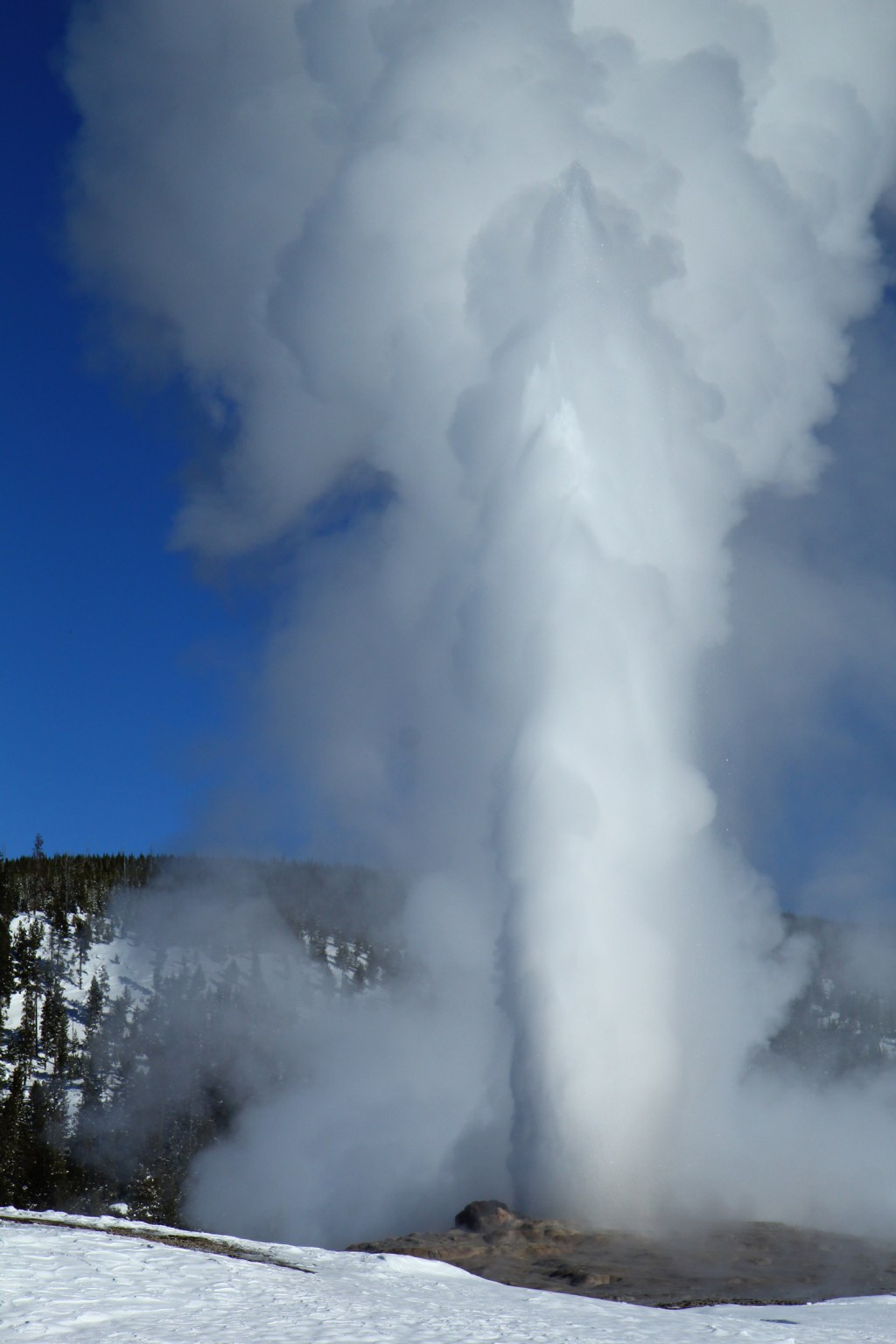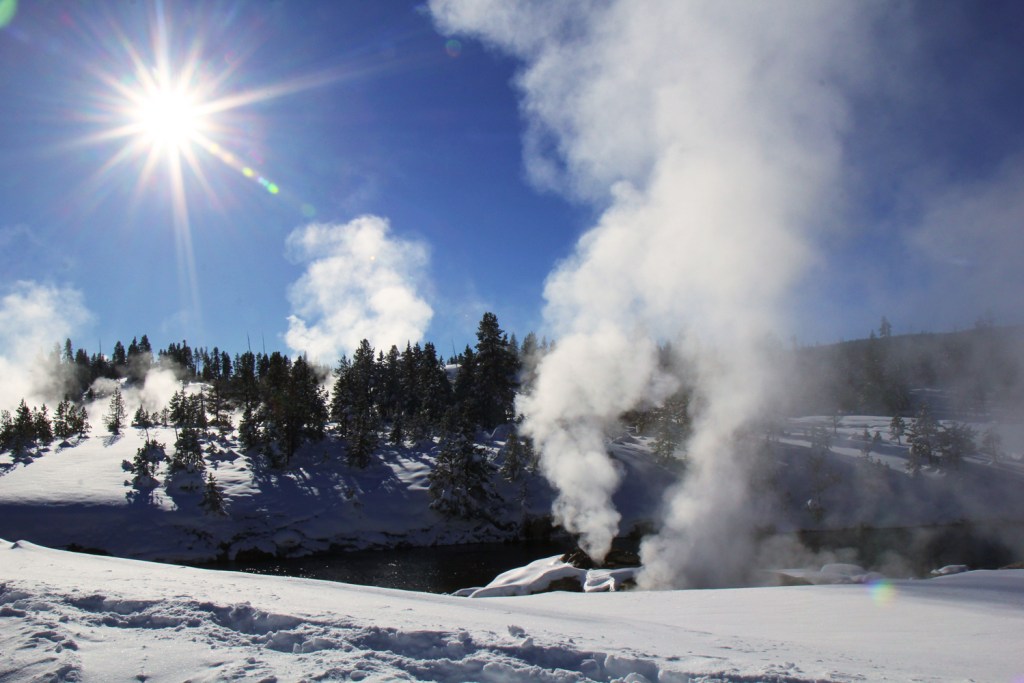It’s winter solstice and the sun is setting. I’m standing next to my mother on the cross-country ski trail between Castle and Old Faithful geysers watching the skies turn to lavender. Old Faithful has just erupted and the remnant steam still floats high in the air. Rounding the bend, we see a group of bison walking one by one across the open basin in front of us. As they move through a low fog that has settled in, the bison disappear and reappear. I look around—we are the only humans in sight, and the cold sting of the air reminds me why.

With over four million visitors per year, Yellowstone is the fifth most-visited national park in the United States. In the summer, 500,000 to 800,000 people per month pay our first national park a visit. But in winter, when the roads are closed to cars and the temperatures drop well below freezing, monthly visitors number only in the 20,000 to 30,000 range—and only about a third of these are overnight visitors. What this means, of course, is solitude is easier to come by for those who are willing (or happy) to brave the elements.
Our first taste of the elements is at Mammoth Hot Springs, the only park entrance open to cars in winter. The boardwalk trail here remains largely open in winter, its three-plus miles easily navigated with good boots. The air temperature registers -17° F and the terraces are a beautiful mix of snow, steam and vivid colors. Intricate patterns of hoar frost and feathery wisps of rime ice cover the boardwalk posts and the surrounding trees. It’s a wonderful sight to take in before continuing the adventure to Old Faithful, only accessible this time of year by park-operated snowcoaches. It’s a four-hour ride in, and a beautiful one at that. At a stop along the way our driver attempts to make us feel hardier by telling us it’s colder here today than in Antarctica. If I forget that it’s summer down there the trick almost works.
Once we get to Old Faithful the skies are already dark, the stars crisp in the frigid air. We check in at the Snow Lodge and then grab a plastic sled to aid in carrying our bags back to our cabin. My nostrils freeze together as we walk.

Getting dressed in the morning is something of an art. The layering required to be warm outside would have us sweating in an instant in our cabin, so we prep for the day in long underwear and then mutually agree on the moment that we start adding our extra layers. We don our snowshoes and head up the trail behind Old Faithful geyser towards Observation Point, hoping to catch the eruption with a view from above. From up here we see a sweeping panorama of the Upper Geyser Basin, the steam of every geothermal feature, including Old Faithful, amplified by the cold air and rising continually up into the sky. Our day stretches out before us from this lookout.
For some, the solitude is enough of a reason to make the trek here during winter. It is indeed a rare gift to experience such incredible and iconic places in Yellowstone without the crowds. Even apart from this aspect, however, the park is truly a different place during the winter months and offers a new world of exploration and insight into a unique ecosystem. Everywhere you look you can see examples of how life has adapted to this harsh environment, be it the slow and powerful swing of a bison’s head as it plows the snow searching for grasses, the leap and dive of a coyote or fox as they hunt for rodents hidden in the snow, or indeed even the absence of bears as they’ve tucked themselves away in their dens, deep in hibernation.

Over the following days we explore on cross-country skis nearby geyser basins Black Sand and Biscuit and are treated to both the snow-globe and bluebird versions of the park. Networks of ski trails cut through forests of lodgepole pine and a number of geothermal areas, each bend begging you to explore further. At some points, the fresh snow falling and the wind mean that we are route-finding, but orange markers along the way offer guidance. The snow falls in big, almost fluffy flakes, many landing on us so intact we can examine their unique patterns. More than a few times we happen upon a geyser that has just started to erupt, each unique in its characteristics of steam, spray and gurgling noises.
On the approach to Biscuit Basin we sail past ghost trees that rim the geothermal features. Here, a herd of bison stretches along the road and on both sides of the bridge crossing the Firehole River. For both their safety and ours, we keep a safe distance from the bison. Especially in this resource-scarce time of year, the bison need to exert as little energy as possible to survive the winter. Humans coming too close, either on foot or snowmobile, could cost them energy they need to make it through.

Such extreme weather means that wildlife moves away from high areas and ridges, congregating in the valleys, along the rivers, and in the geyser basins. The geothermal areas this region is so well known for aid in the winter survival of many species, offering opportunities for food and warmth. The hot springs flowing into the area’s rivers also keep the water from freezing, providing food and habitat for visiting trumpeter swans and resident river otters. In the Lamar Valley, the howl of wolves is a common part of the winter soundscape, and it just so happens to be the best season to spot them, as well.
As we ski out of Biscuit, the Fairy Creek trail and signs for Mystic Falls beckon and speak of adventures to come another time. Down trail, a coyote limps towards us, one of its front legs injured. It pauses, staring at us as we stop on a small bridge over a creek. Clearly it was hoping to cross here. The coyote continues past for a short while, then sees the dozens upon dozens of bison just ahead on this path. It stops and reevaluates as we cross the bridge to make an opening. Sure enough, as soon as we are past the coyote backtracks and crosses the bridge, disappearing into the snow-filled meadow and following the tracks we have laid. Again I look around and we are the only human souls in sight.
I take a deep breath and my nose freezes up but I couldn’t be happier with this time and this place—and I know I have winter to thank for it. The opportunities for solitude and wildlife viewing are indeed unparalleled at this time of year, but moreover I’ve come to appreciate getting a new perspective, a new understanding of our parks and the life and land they protect, and with it a deeper gratitude for these unique ecosystems. It’s a great reminder that there’s a whole different world out there in the off-season, one that is worth every bit of effort to explore it.
Get maps, descriptions, and photos for more parks completely free and viewable offline by downloading REI’s National Parks Guide and Maps on iOS or Android.
